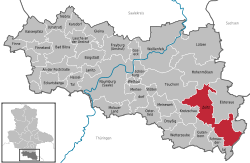Zeitz
| Zeitz | ||
|---|---|---|
|
| ||
| ||
 Zeitz | ||
Location of Zeitz within Burgenlandkreis district  | ||
| Coordinates: 51°2′52″N 12°8′18″E / 51.04778°N 12.13833°ECoordinates: 51°2′52″N 12°8′18″E / 51.04778°N 12.13833°E | ||
| Country | Germany | |
| State | Saxony-Anhalt | |
| District | Burgenlandkreis | |
| Government | ||
| • Mayor | Volkmar Kunze (FDP) | |
| Area | ||
| • Total | 87.15 km2 (33.65 sq mi) | |
| Population (2015-12-31)[1] | ||
| • Total | 29,052 | |
| • Density | 330/km2 (860/sq mi) | |
| Time zone | CET/CEST (UTC+1/+2) | |
| Postal codes | 06711, 06712 | |
| Dialling codes | 03441, 034423, 034426 | |
| Vehicle registration | BLK, HHM, NEB, NMB, WSF, ZZ | |
| Website | German: Stadt Zeitz | |
Zeitz (Upper Sorbian: Žitč) is a town in the Burgenlandkreis district, in Saxony-Anhalt, Germany. It is situated on the river Weiße Elster, in the triangle of the federal states Saxony-Anhalt, Thuringia and Saxony.
History
Zeitz was first recorded under the name Cici in the synode of Ravenna in 967. Between 965 and 982, it was the chief fortress of the March of Zeitz. Zeitz was a bishop's residence between 968 and 1028, when it was moved to Naumburg. Beginning at the end of the 13th century, the bishops again resided in their castle at Zeitz. The Herrmannsschacht (built in 1889) is one of the oldest brick factories in the world. It was captured by Swedish troops during the Thirty Years' War and was given to Electorate of Saxony in 1644. It was centre of Saxe-Zeitz between 1657 and 1718 before returning to Electorate (Became Kingdom of Saxony in 1806). In 1815, it was given to Kingdom of Prussia and became district (kreis) centre in Merseburg region (regierungsbezirk) of Province of Saxony till 1944, when it became part of Halle region. It became a county free city between 1901 and 1950. It was occupied by USA troops on 27 April 1945 and was given to Soviet ones on 1 July 1945. It was a district centre in Halle region of Saxony-Anhalt state between 1945 and 1952 and again 1990 and 1994 and in Halle bezirk between 1952 and 1990. It lost status centre of county and became part of Burgenlandkreis on 1 July 1994.
A bombing target of the Oil Campaign of World War II, the Brabag plant northeast of Zeitz used lignite coal to synthesize ersatz oil[2] – forced labor was provided by the nearby Wille subcamp of Buchenwald in Rehmsdorf and Gleina.. In the middle of the 1960s work started on the "Zeitz-Ost" residential area, and in the mid-1980s, housing estates such as the "Völkerfreundschaft" (English: International Friendship) were built.
On 18 August 1976, the Protestant clergyman Oskar Brüsewitz from Rippicha burnt himself to death in front of the Michaeliskirche. This was a protest against the DDR system. The town was an industrial centre until German Reunification made many companies in eastern Germany uncompetitive. The town still has a large sugar factory.
Main sights
Zeitz sights are predominantly situated along the Romanesque Road (point 52).
- Schloss Moritzburg, a baroque-style castle with the cathedral of St. Peter and Paul. The 10th century crypt displays 17th century tin coffins including that of Moritz, Duke of Saxony.
- Michaeliskirche (1154), originally a Roman basilica and contains a 1517 original of Martin Luther's 95 Theses.
- Town Hall (1509, rebuilt in 1909). It is a Gothic structure that, together with restored houses and 3 market-places, provides Zeitz' medieval appearance.
- Herrmannsschacht, a technical monument in a former brick factory.
Sons and dauhters of the town
Up to 1925
- Christian August of Saxe-Zeitz (1666-1725), Archbishop of Gran
- Anna Magdalena Bach (1701-1760), second wife of the composer Johann Sebastian Bach
- Clemens Denhardt (1852-1929), Africa explorer
- Gustav Denhardt (1856-1917), African explorer
- Kurt Floericke (1869-1934), natural scientist, naturalist and author
- Ewald André Dupont (1891-1956), film director and screenwriter
- Heinrich Troeger (1901-1975), lawyer, financial expert and SPD politician
- Ewald Riebschläger (1904-1993), water jumper (European Champion 1927 and 1931)
- Karl Walther (1905-1981), painter
- Gotthard Handrick (1908-1978), Olympic champion and fighter pilot
- Fritz Gödicke (1919-2009), coach of the soccer national team of the GDR
- Horst Wende (1919-1996), orchestra conductor, arranger and accordionist
- Heinz-Günther Lehmann (1923-2006), swimmer and European champion as well as Olympic athletes
After 1925
- Manfred Kaiser (born 1929), footballer and coach
- Rudolf Drößler (born 1934), author and science journalist, from 1991 to 1997 Stadtschreiber and town chronicler
- Bernd Bauchspiess (born 1939), soccer player, Olympic athlete 1964
- Hans Zierold (born 1938), swimmer, Olympic finalist in 1956 and 1960
- Klaus Trummer (born 1945), canoeist, Olympic athlete 1972
- Jürgen Kretschmer (born 1947), canoeist, Olympic athlete in 1972
- Martina Falke (born 1951), canoeist, Olympian competitor 1972
| Wikimedia Commons has media related to Zeitz. |
References
- ↑ "Bevölkerung der Gemeinden – Stand: 31.12.2015" (PDF). Statistisches Landesamt Sachsen-Anhalt (in German).
- ↑ . Becker, Peter W. (1981). "The Role of Synthetic Fuel In World War II Germany: implications for today?". Air University Review. Maxwell AFB.


